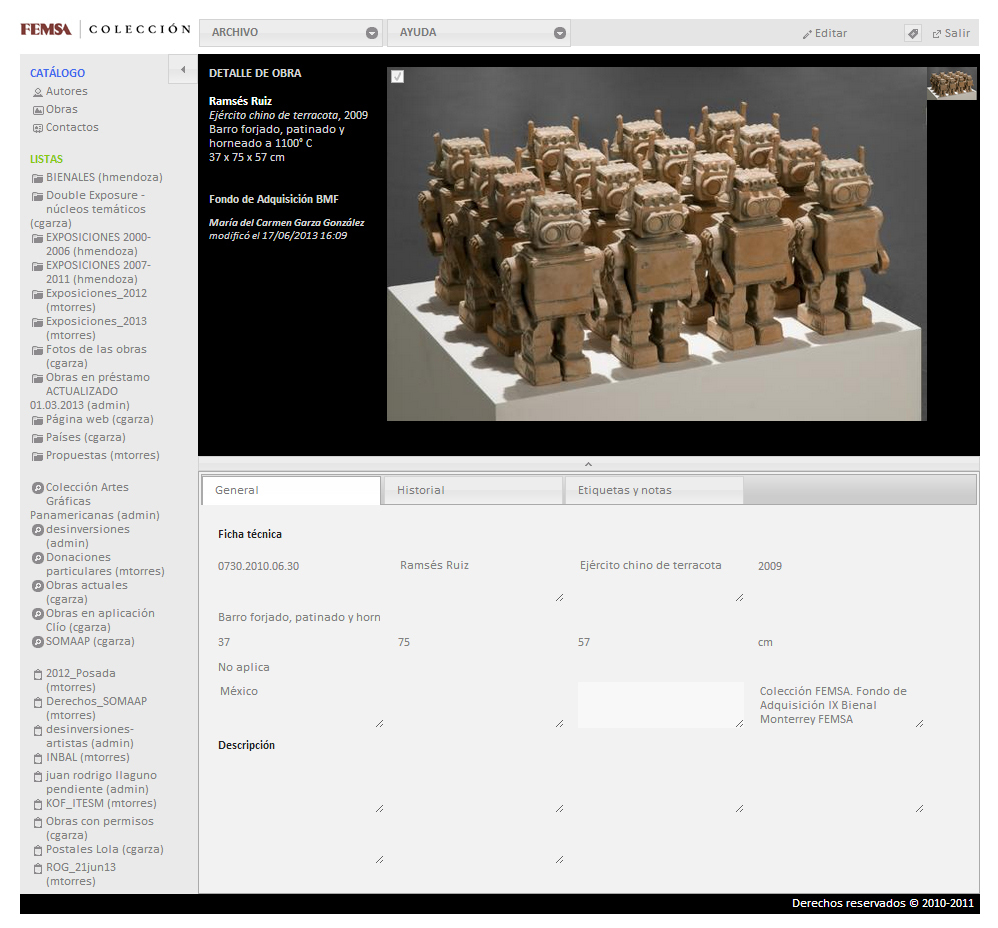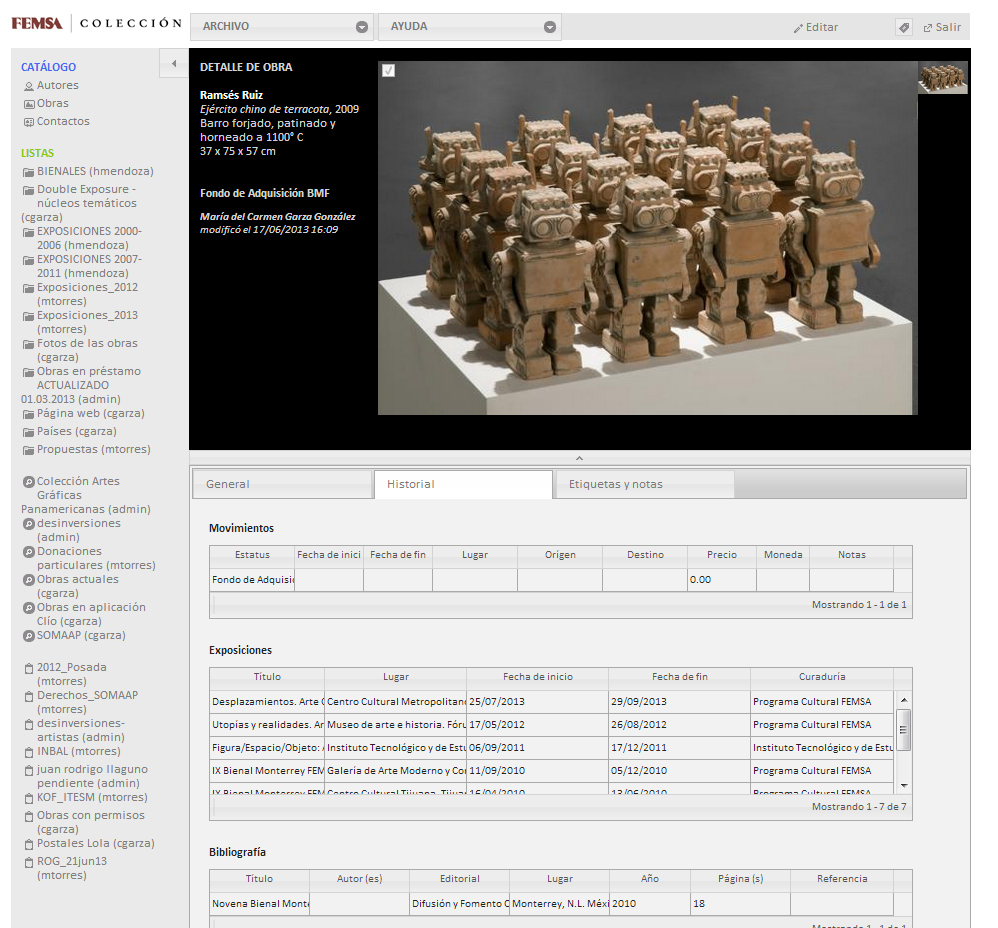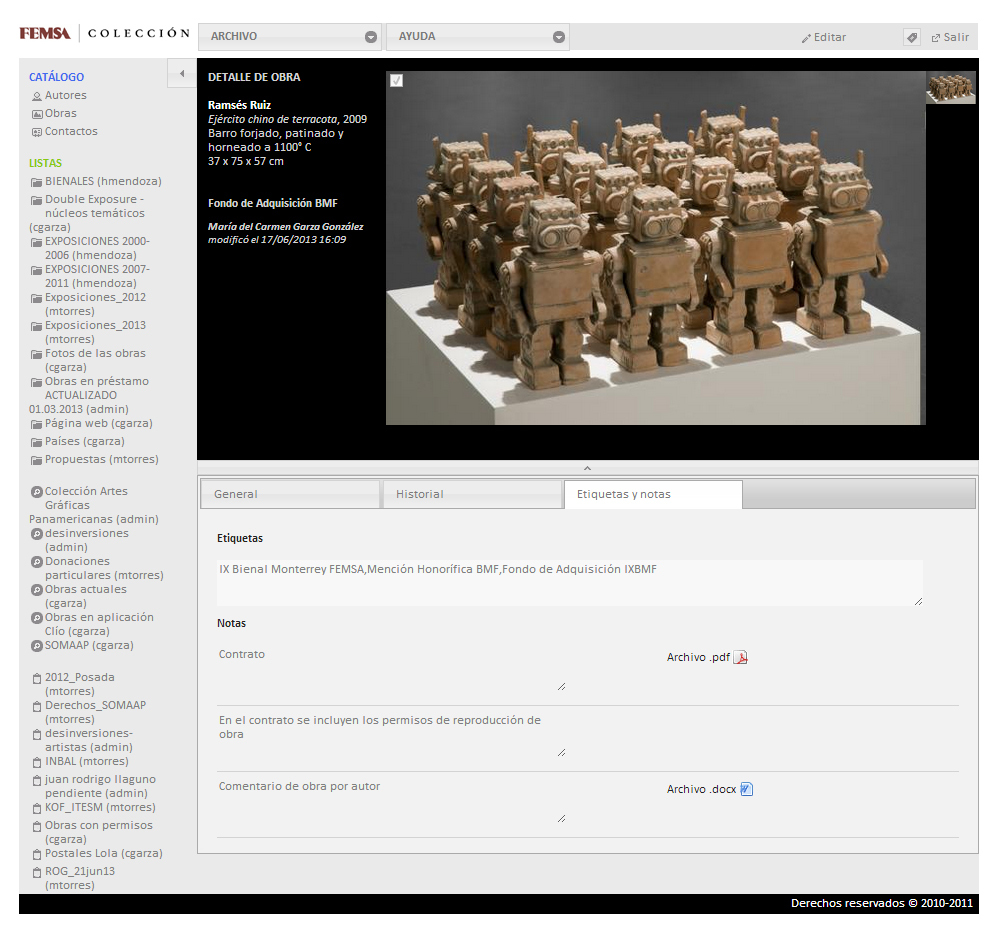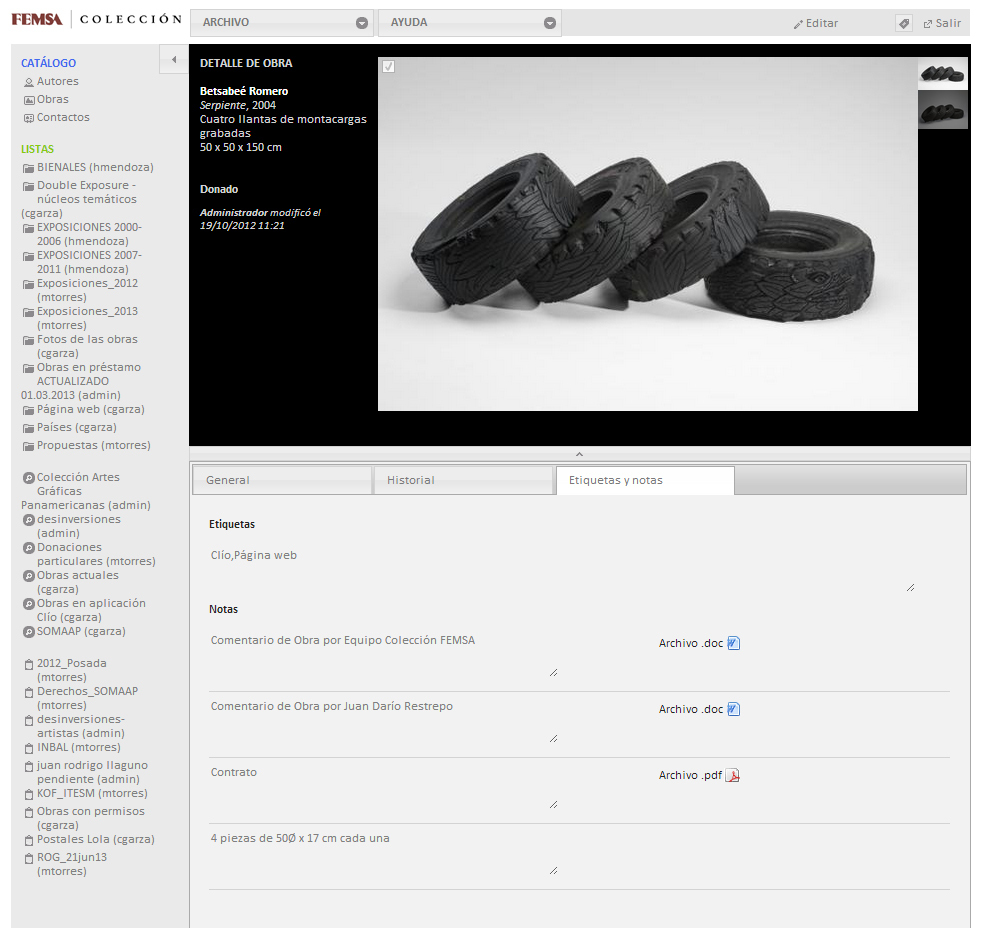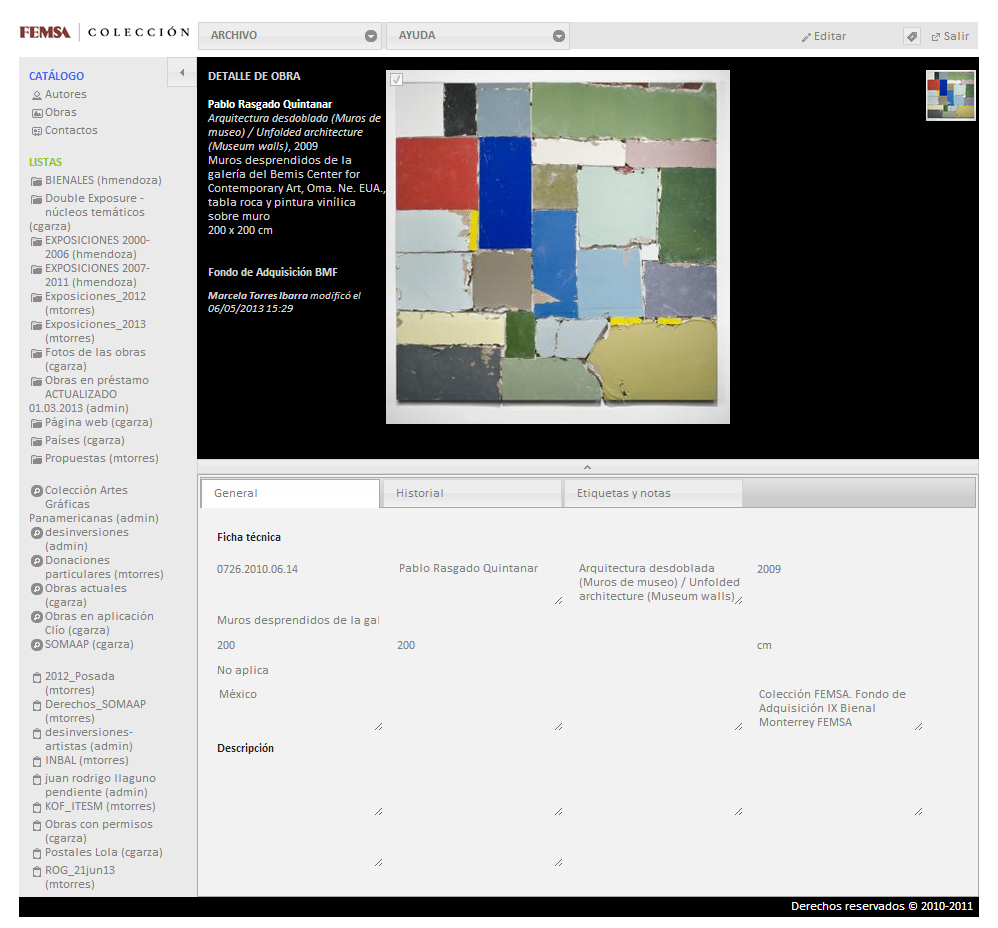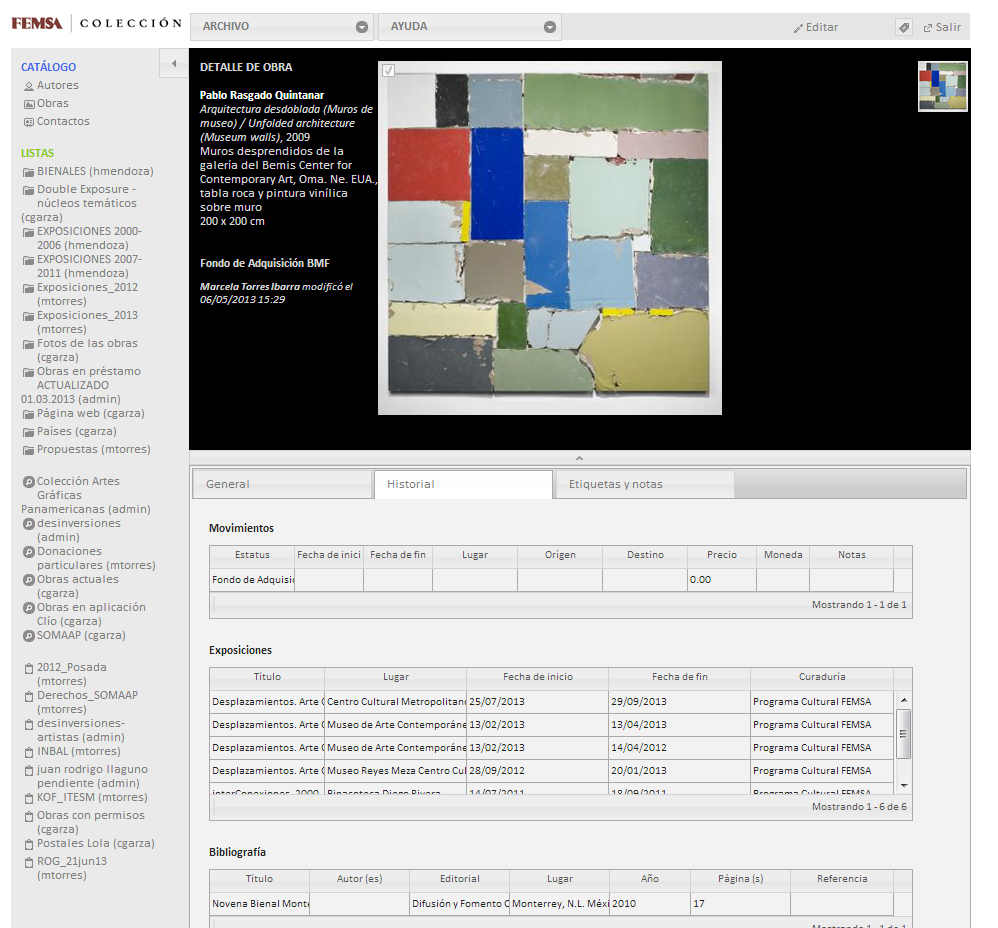Courtesy of Colección FEMSA
Colección FEMSA is a corporate collection of Latin-American art based in Monterrey, Mexico. With more than 1,000 pieces from 800 artists, the collection spans 17 countries and dates from the beginning of the 20th Century to today[i]. It is part of the social responsibility program at FEMSA, the world's largest Coca-Cola bottler, operator of OXXO, the largest convenience store chain in Mexico, and owner of interests in global beer operations through the Heineken Group[ii].
The collection specializes in travelling exhibitions for Mexican and international institutions. A nine-person team manages all aspects of planning, from building crates and preventive conservation to facilitating partnerships with museums and other cultural organizations, culminating in up to twelve different shows each year. While a relatively small collection, the management challenge for this organization is having artwork constantly on the move. This case study concentrates on how Colección FEMSA meets this challenge through the help of a collection management application, Spaces for Art.
Where do all the works come from? Idiosyncrasies of an art collection
The collection predecessor, Museo de Monterrey, was founded in 1977, when executives of the company decided that in addition to being a source of employment, FEMSA should offer cultural opportunities to the city that, being far from the nation’s capital, lacked such resources.
Museo de Monterrey operated from 1977 until 2000. From its inception, they had a vision of creating a collection that concentrated on Latin-American art in general and Mexican art in particular. At first most accessions occurred through gifts from board members or donations from individual artists.
Later, through the donation and acquisition of other collections such as Colección de Artes Gráficas Panamericanas (AGPA) and Window South (from the American art collector Paul Cook), the collection grew in numbers and expanded its impact. In 1992, with the creation of Bienal Monterrey FEMSA, the institution found another way to foster the arts in Latin America and grow its collection: a biennial juried exhibition with two prizes and an acquisition fund.
As the city of Monterrey grew, its cultural offerings multiplied, and FEMSA grew to a point where it had constituents across the country and internationally. To better serve their community it was decided that the mission of the collection would be to foster the understanding of contemporary Latin American art through a travelling exhibition program of FEMSA’s corporate collection.
How did they keep track? The ubiquitous spreadsheet
The Museo de Monterrey created its first digital registry on an Excel spreadsheet that contained basic fields: author, title, medium, size, and year. Since the collection rarely travelled at that point, and because a physical archive existed to house every piece, the spreadsheet worked well enough. However, this initial copy did not track other important information, such as how each piece was acquired.
When the travelling exhibitions began upon the close of the Museum in 2000, Colección FEMSA needed a more sophisticated collection management system. It acquired a license for Artsystems, a pioneering collection management software that was, theoretically, an improvement from the limited capabilities of a spreadsheet. However, the new software had so many fields that registering a transaction was a cumbersome process and technical support was costly. After a couple of years, FEMSA decided to go back to a more sophisticated version of its original spreadsheet, one that made it easier to filter and generate lists but that was still prone to errors and that didn’t provide an immediate visual reference to each work.
Looking for other options: Spaces for Art
As the number of annual travelling exhibitions increased, FEMSA understood that having a good collections management software would not only make its day to day operations more efficient, but also help in designing shows and researching its holdings. Staff members looked into other software options, but found that many required some degree of programming knowledge and that the “out of the box” versions were too complex. During this process, however, FEMSA identified its needs by thinking about (1) the processes that happen when a piece becomes part of the collection, (2) the reasons the previous software didn’t fit their needs, and (3) the limitations of the current Excel spreadsheet. The results of this process indicated that the next system needed to provide:
- Collaboration capabilities for multiple users
- Efficient transaction registration
- Intuitive interface and reliable technical support
- Capacity to create and export lists
- Searching and filtering options
A solution was found in an application developed by a Mexican startup, Spaces for Art. Being a small company, they were able to provide personalized customer care, but also guarantee regular updates to its product. This balance resulted in a lower investment cost and provided a certainty about regular updates in the future, an important advantage over a custom made collections management software.
The result was the implementation of a system that can track multiple images, descriptions and specifications, mounting instructions, transactions, provenance, exhibition history, copyright information, and a bibliography for each piece. The system also allows information about artists to be registered; their biography, resume, artist statement, gallery representation, contact information, and additional notes. Users can create templates for common forms such as condition reports, and can also generate and export lists as Power Point presentations or customizable spreadsheets.
Is everything better now? Implementation process
It took about one week to clean up the existing Excel spreadsheet to make it compatible with the fields needed for Spaces for Art; the uploading itself took a matter of minutes. The photo registry of the collection was then formatted in a standard resolution and uploaded, and lastly, an intern was hired to digitize the paper files for each piece. When that digitization was complete, the staff attached the relevant digital files to the notes section in each record.
Only after inputting all the necessary data did the application become useful for planning. However, because the application is used regularly, it remains up to date. When the implementation process ended and regular use began at Colección FEMSA, four main areas improved:
- In-house operations: Staff access to the database allows for easier collaboration and a more streamlined work process. There is no longer a need to send multiple versions of a document back and forth or to double check its accuracy. At any particular moment, FEMSA knows where a specific piece is being exhibited and when it will come back, or the status of copyright permissions needed to include an image on a press package.
- Service to artists: It is not uncommon for staff to receive a call from artists asking about the publication of a catalogue or the specific details of an exhibition in which their piece was featured. Having all this information readily accessible makes it possible for artists to receive the most accurate and current information about their work.
- Research: Spaces for Art provides the ability to add tags to specific works. Colección FEMSA uses this feature to tag characteristics of a work that might not be reflected on the standard fields, such as if the piece is a self-portrait or if it belongs to a specific art movement. It is now possible for a curator to ask, for example, for all the pieces that are landscapes created in a specific time period, and have a list created within minutes.
- Partnerships: The ability to create lists allows FEMSA to share relevant information with receiving institutions. Customized spreadsheets are exported when lending a show, allowing for technical details and artistic notes to be included, resulting in a straightforward receiving process.
After seeing what a collection management software can do for an organization, one caveat should be noted: Spaces for Art is not designed to be all encompassing. Organizations still need to keep high resolution files of their photographic archives, store physical copies of printed materials, create condition reports, and acquire copyrights. Most importantly, organizations still need to work to establish partnerships with other institutions and conduct research into their existing collection. A collections management system won’t do those jobs, but it will certainly make them easier to manage.
*Special thanks to Marcela Torres Ibarra from Colección FEMSA for a great conversation about collections management, the role of arts managers, and the relevance of travelling exhibitions. This case study would not have been possible without her input.
[i] http://www.coleccionfemsa.com/
[ii] http://www.femsa.com/en/about/faqs/
All images courtesy of Colección FEMSA



